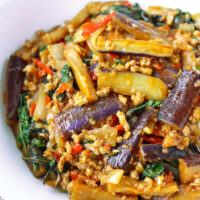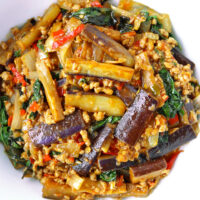 Buy Now →
Buy Now → Thai Eggplant Stir-fry (with Chili Paste, Pork & Basil)
Juicy eggplant strips and ground pork get tossed with aromatics and fragrant Thai sweet basil in a mouthwatering sauce featuring Thai chili paste (Nam Prik Pao) in this quick and easy weeknight stir-fry!
- Prep Time: 15
- Cook Time: 16
- Total Time: 31 minutes
- Yield: 3 1x
- Category: Dinner
- Method: Stir-fry
- Cuisine: Thai
Ingredients
Scale
For the Sauce:
- 1.5 TBLS Thai Chili Paste/Chili Jam (Nam Prik Pao)
- 1 TBLS Oyster Sauce
- 1 TBLS Light Soy Sauce
- 1 TBLS Fish Sauce
- ½ TBLS Tamarind Paste
- ½ – 1 TSP White Sugar (optional), to taste (see notes)
- 2 TBLS Water
For the Thai Eggplant Stir-fry:
- 300–320 grams / 10.5-11.3 ounces (1 large) Chinese or Japanese Eggplant – cut into 1.5-inch long strips
- 6 Garlic cloves – roughly chopped
- 2–8 Red Chilies (Bird’s Eye preferred, but any small hot red chilies will work), to taste – roughly chopped
- 3–5 Prik Kee Nu Green Chilies (optional), to taste – roughly chopped
- 1 Large Red Chili – thinly sliced at an angle
- 1/3 medium Yellow Onion – cut into ¼-inch strips, then cut in half
- 3.5 TBLS Canola Oil (or any other neutral-flavored cooking oil with a high smoke point)
- 150 grams Ground Pork / 5.3 ounces (or ground chicken, beef, or turkey)
- ¼ TSP Ground White Pepper
- 1.5 cups Thai Sweet Basil Leaves – picked off stems, washed and pat-dried (substitute with Thai holy basil or Italian basil if unavailable)
- 1 TSP Corn Starch + 1/3 cup Water (mixed together to make a slurry)
- To Serve (optional): Steamed rice
Instructions
Prep:
- Prepare the fresh ingredients: Chop/prepare the eggplant, garlic, red chilies, Prik Kee Nu green chilies (if using), large red chili, yellow onion, and Thai sweet basil leaves as indicated in the ‘Ingredients’ section. Transfer the eggplant to a bowl filled with water and soak for 15-20 minutes. Using a mortar and pestle, pound the garlic, Bird’s Eye red chilies, Prik Kee Nu green chilies into a coarse paste and set aside. (Or smash with the back of your knife and finely chop if you don’t own a mortar and pestle.)
- Make the sauce: Whisk together the Thai chili paste, oyster sauce, light soy sauce, tamarind paste, and water in a measuring cup (for easier pouring) or small bowl and set aside.
- Make the corn starch slurry: Mix the corn starch and water in a measuring cup or bowl and set aside.
For the Thai Eggplant Stir-fry:
- Cook the eggplant: Heat 2 tablespoons of canola oil in a large wok over medium-high heat. Once hot, add the eggplant and cook for 8-10 minutes, tossing occasionally, until slightly browned and tender. Transfer to a clean bowl and return the wok to the stovetop. (Don’t worry if the eggplant isn’t completely tender yet. The residual heat will allow it to continue cooking and become tender in the bowl.)
- Stir-fry the aromatics: Heat the remaining 1.5 tablespoons of oil over medium-high heat in the wok. Once hot, add the onion and stir-fry for 30 seconds until slightly softened. Then add the smashed garlic chili paste and large red chili and toss to combine for 30 seconds until fragrant.
- Cook the pork: Add the ground pork and ground white pepper. Cook for 2 minutes, breaking up the lumps with your spatula, until just cooked.
- Add the eggplant and sauce: Add the eggplant back into the wok and pour in the sauce. Toss briefly until everything is combined well and coated in the sauce.
- Add the corn starch slurry: Give the corn starch slurry a quick stir with a spoon (the corn starch will have settled at the bottom of the measuring cup/bowl), then pour it into the wok. Toss for a minute until the sauce has thickened.
- Stir through basil: Add the Thai sweet basil leaves and briefly toss until slightly wilted – about 15-20 seconds, then switch off the heat.
- To Serve: Transfer to a serving dish and serve immediately with warm steamed rice.
Notes
Ingredient Notes, Cook’s Tips, and FAQs
- Thai Chili Paste/Chili Jam (Nam Prik Pao): This is a savory-sweet chili paste that has the texture of jam. It is available in small glass jars and goes by “Thai chili paste”, “roasted chili paste”, and “roasted chili paste in soybean oil”. Look for it in Thai or Asian grocery stores, or purchase it online. I use Mae Pranom brand, which is less sweet than the Pantainorasingh (Pantai) brand Thai chili paste. When making the sauce, avoid adding too much oil from the jar and use mostly the paste. You can use this condiment in other stir-fries, soups, and in sandwiches too. It will last for a few months in the fridge once opened.
- Tamarind Paste/Concentrate: This sour and slightly sweet paste comes in small jars, and can be found in the Asian aisle of some large supermarkets, Asian and Thai grocery stores, or purchased online. I use Talad Thai brand. Some brands are more sour than others, so you may need to use more or less of the paste than what I’ve indicated. Make sure to use a Thai tamarind paste and not an Indian one. The latter is black and sticky, and not ideal for this recipe.
- Chilies: Use less or more Bird’s Eye and Prik Kee Nu chilies based on your heat level preference. The large red chili is mainly used for color and is very mild. Substitute it with sliced red bell pepper, or leave it out if you wish.
- White Sugar: Depending on how sweet your Thai chili paste is, you may not need to add any sugar (I didn’t as I find that the Thai chili paste from Mae Pranom brand is plenty sweet enough for me). You may want to taste your Thai chili paste on its own to gauge how sweet it is and decide if you need to add any sugar to the stir-fry sauce.
- See ‘Variations’ section in the post above if you’d like to customize this stir-fry.
Nutrition
- Serving Size: 1 serving
- Calories: 423
- Sugar: 15.9g
- Sodium: 976mg
- Fat: 29.1g
- Saturated Fat: 5.2g
- Unsaturated Fat: 21.1g
- Trans Fat: 0.1g
- Carbohydrates: 29.8g
- Fiber: 5.9g
- Protein: 14g
- Cholesterol: 36mg
Find it online: https://thatspicychick.com/thai-eggplant-stir-fry/










